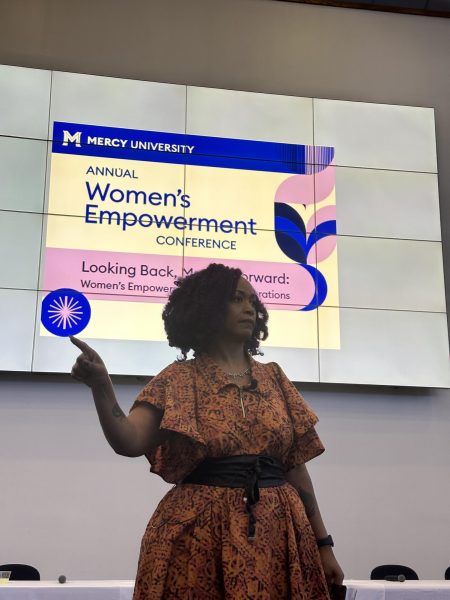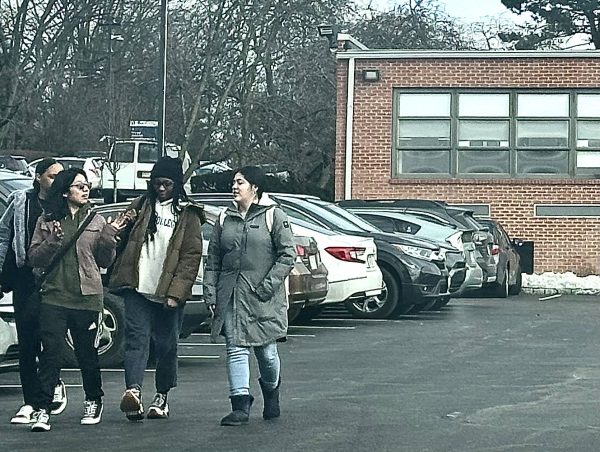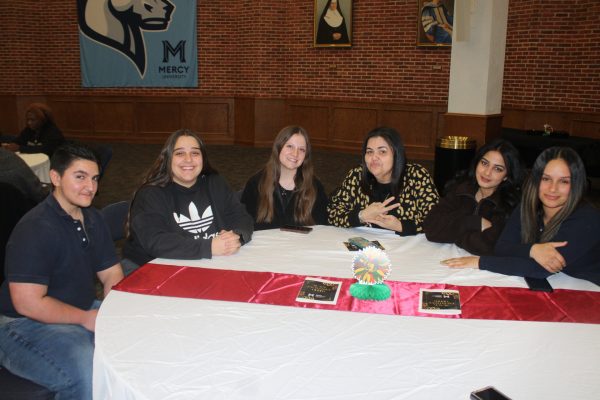Walking Lost In The Darkness
While 40,000 Take Their Lives A Year, The Pain Lingers With Those Who Remain
“The call of death must be really great,” says Mercy College English professor Melinda Corey when referring to the loss of her daughter Martha Corey-Ochoa, who committed suicide in August of 2012. “The rest of us have no idea.”
It was move-in day for most college freshmen at Columbia University, and Martha’s parents had just helped settle her into a single-room-dorm on the fourteenth story of Columbia’s John Jay building. After unpacking, Melinda Corey and George Ochoa said what would be their final goodbyes to their 18-year-old daughter.
Corey remembers her last phone call with her daughter – she had said she was having emotional trouble.
“She had been suicidal that day. We talked to her that night, and she said she wasn’t going to kill herself, and that she knew we loved her. We finished talking to her at 11 p.m. At 2 a.m., we got a knock on our door.”
Martha Corey-Ochoa had jumped from her dorm window shortly after 11 p.m.
Every 13 minutes, a suicide occurs in the United States.
There are approximately 40,000 Americans whose lives are lost to suicide – the tenth leading cause of death, according to the American Foundation For Suicide Prevention. And yet answers on how to defeat suicidal tendencies are in dispute by experts, allowing those at risk to wander alone – in darkness.
This past October, Mercy College held an ”Out of the Darkness Walk” in Battery Park. The walk raised funds along with awareness about depression and suicide, while comforting and supporting those who lost a loved one to suicide. Mercy’s women’s lacrosse team also participated in the walk, raising $3,000 through donations and home game raffles.
Suicide is often referred to as the second leading cause of death when speaking among the college student population, according to data collected by the Suicide Prevention Resource Center.
Though most campuses provide low or no-cost mental health services or refer their students to off campus services, SPRC indicates through survey data that many students who need help aren’t asking for it.
Corey remembers Martha as quiet and intense. “We said that from the day she was born.”
She began reading at the age of three and by the time she was sixteen, she had learned Latin, Greek and taught herself Russian. Some of Martha’s interests consisted of writing, politics and playing the violin.
“She was the smartest person I’ve ever met,” Corey says proudly, although she adds, Martha never thought highly of herself.
Martha was believed to be mentally ill. Corey explains that although her daughter was never diagnosed with a specific mental illness (because of her young age), during the last four years of Martha’s short-lived life, she had been institutionalized, medicated and began seeing a psychiatrist after two suicide attempts. Corey says that she and her daughter never spoke of the cause of the previous suicide pursuits.
Mental illness is sometimes seen to be less urgent than physical health when it comes to providing substantial care. When physical health diseases such as HIV, breast cancer and, even more recently publicized, amyotrophic lateral sclerosis, also known as ALS, begin to abruptly threaten lives, it emerges into a public health crisis that is researched and invested in instantaneously due to the egoistic thought that ‘this illness could happen to me or a loved one,’ so answers become arrogated.
Mental illness is not always the leading factor in suicidal thoughts. Often extreme depression, created by tragedy or loss, can be the cause of a suicide attempt.
Rebecca Fowler, 21, a senior at Mercy College, held a well-pointed knife to the inside of her wrist.
“Just pointing it at my wrist alone hurt, and I remember thinking to myself this is going to hurt, so I probably shouldn’t do this,” Fowler, then a freshman in high school, recalls her first actual attempt at suicide. After losing both of her parents within six months of each other a few years earlier, she was searching for affection while struggling to fit in with her aunt’s family.
“We were constantly arguing about things, and I just felt as though I didn’t belong.”
Her second attempt would be during her freshman year at Mercy College.
“I was going through a really emotional time,” Fowler admits. She stated she was planning to take pills. What stopped her was an inner voice that reminded her, “If you kill yourself, that’s it. It’s permanent. You aren’t coming back,” which helped her understand that killing herself wouldn’t solve any of the issues she was dealing with.
The thought of suicide arose in Fowler most recently this past September.
“I didn’t have a place to stay. My family wasn’t being understanding. They wanted me to drop out of school, and I didn’t see how anything was going to work out.”
With prospects not looking well for her future, Fowler says that she decided to go for a walk and was going to allow a car to hit her. During her walk she again had an epiphany, realizing her life resulting in suicide would have no point.
While Fowler, a psychology major, believes that her suicide has nothing to do with mental illness, Melinda Corey believes mental illness is a major cause in suicide deaths and feels as though the topic isn’t taken seriously enough.
“In this country, we do not take mental health seriously. We consider it as a moral feeling. ‘Oh, she’s bipolar? Well, she just has to pull herself up by the bootstraps,’ but it’s not like that. Nobody says, ‘Oh, you have cancer? Just don’t think about it, it will get better.’”
One thing Melinda Corey says she has learned from this experience is that mental illness is indeed a physical illness, and has nothing to do with how morally good one is, but instead what chemicals are awry in the brain.
Corey also believes the more the public hears about mental health being a serious illness and the more insurance companies cover treatments the more help people will “be willing to get and will get.”
“The National Institutes of Health — the largest source of research money — spends a small fraction on suicide compared with diseases such as breast and prostate cancer that result in as many or fewer American lives lost. The suicide research budget for the National Institute of Mental Health (NIMH) has actually been shrinking since 2011,” according to a report constructed by USA Today.
Mercy College often reminds its students to speak with a counselor, professor, classmate or friend if one is having a difficult time.
At the beginning of the fall 2014 semester, Mercy posted bulletins at each of three three campuses displaying informative statements such as, “50 percent of college students report suicidal ideation at sometime in their life,” and “Sigma is a shame, shame causes silence, silence hurts us all.”
The Centers for Disease Control and Prevention believes that the most substantial strategy for preventing suicide is to learn the warning signs. These signs can include individuals talking about harming themselves, increasing substance use, feeling alone, and history of depression or other mental illness.
Despite her previous efforts to end her life, Martha went on to graduate as valedictorian from Dobbs Ferry high school, where she gave her commencement speech, quoting Shakespeare’s tragic character, Othello, who commits suicide.
“Before we act, we must consider the consequences of our actions,” she cited.
Suicide is often seen to be an act of selfishness. However, Melinda Corey sees it differently. “The call of death must be really great. The rest of us have no idea. When you are hungry, do you not eat? When a person cannot see anything else but die, the person sees death as the right thing to do, the only thing to do.”
Experts believe that for every suicide, there are at least 10 others who suffer from emotional despair.
Since the death of their daughter, Corey says that in order to cope with their loss, she and her husband just simply “live” along with giving out an annual scholarship in the memory of Martha. The Martha Corey-Ochoa Memorial Scholarship usually goes to the valedictorian of the Dobbs Ferry high school, as a tribute to Martha and her appreciation for intelligence.
Although Corey feels there are many ways to answer whether or not she could have prevented her daughter from jumping that night, she answers by saying, “This is all thinking about something you cannot change,” adding “Everyone who has experienced a suicide in their family lives that day over and over in their head. You cannot re-write the past, everyone knows that and it’s a cliché to say it, but in this case it is one of those cliché’s that is true.”
Fowler takes a religious approach when dealing with her issues by, “having faith in God,” and advises those who may have had or may have suicidal thoughts to stay encouraged. She also tries to keep in mind, “you never know what someone is going through, and you can’t treat people any old way. A simple hello could be a change in somebody’s life.”
Corey advises those who have experienced similar difficulties to live. “Suicide is a permanent solution to a temporary problem.” She adds, “Just as all good things pass, bad things pass. Let these smaller minuscular things pass whether it’s a grade, a boyfriend, a family problem.
“Let it pass.”
She pauses for several seconds before she goes on to say that the most important concept for any parent to think about is that you want your child to live. “It doesn’t matter if the child wins homecoming king or is voted most likely to succeed or gets a big scholarship to Harvard. What you want is that the child lives, and when you think about that, all else falls away.”
She pauses again, because she can relate to her own words. “That’s a really hard lesson to learn.”

Maritza is a senior majoring in journalism and is in her first year on the Impact. Although she greatly regrets waiting so long to join such a great...












